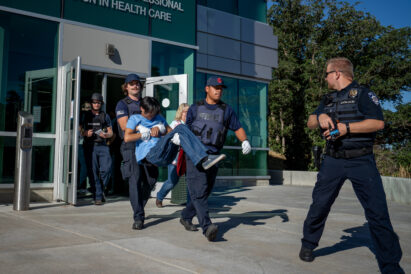Weber County Sheriff’s Office unveils warehouse; more expansion in works
- Weber County Sheriff Ryan Arbon poses in the training facility in the new sheriff’s office warehouse in Ogden on Friday, Feb. 25, 2022.
- Motorcycles are stored inside the new Weber County Sheriff’s Office warehouse in Ogden on Friday, Feb. 25, 2022.
- Plans showing part of the proposed expansion of the Weber County Sheriff’s Office facilities in Ogden are photographed Friday, Feb. 25, 2022, at the public unveiling of the sheriff’s office’s new warehouse facility. The area in yellow to the right in the photo represents new jail pods and the area in yellow to the left represents new medical and mental health facilities for the jail.
- Weber County Sheriff Ryan Arbon stands in the new sheriff’s office warehouse in Ogden on Friday, Feb. 25, 2022.
- Equipment is stored inside the new Weber County Sheriff’s Office warehouse in Ogden on Friday, Feb. 25, 2022.
OGDEN — Representatives from the Weber County Sheriff’s Office unveiled a large new warehouse on Friday that will also enhance training operations.
But longer term, more expansion is potentially in the works at the adjacent jail facility — the addition of a medical wing, expansion of inmate pods and the addition of a new community-release center. The price tag could be tens of millions of dollars.
Sheriff Ryan Arbon, a handful of elected officials and others attended the unveiling Friday of the new 33,000-square-foot warehouse structure, sitting northwest of the main sheriff’s office and jail facility at 1400 Depot Drive in Ogden. It houses a training room that can comfortably accommodate 128 people — and as many as 400, depending on the configuration — which will make it possible to more quickly train sheriff’s officials.
“More training, more often, with more people and with other agencies,” Arbon said, describing the upshot of the new facility. The old training facility in the existing sheriff’s office building can hold 35-40 people.
The building also consolidates and expands on other scattered storage sites, centralizing the location of search and rescue, SWAT, emergency management and other equipment. Some equipment had to be stored outdoors, which can cause it to wear out more quickly, and the new facility gets it all indoors.
The structure cost $2.2 million, with the money coming from the county’s general fund. The work was largely complete by last December.
Notably, officials at Friday’s open house also provided some of the preliminary details of plans to expand the existing jail facility, a multimillion-dollar prospect. Last June, county officials hired a contractor to look into expanding the jail’s medical and mental health facilities.
The current medical facilities are “just not enough in any way, shape or form,” said Chief Deputy Phillip Reese, who’s helping oversee the expansion planning.
But the current expansion proposal is larger, with a very preliminary price tag of $62 million. Aside from the new medical and mental health wing, the plans now call for additional pods adjacent to the existing jail that would expand its capacity by 384 inmates to 1,272. The current capacity is 888, though Reese said officials like to keep the max at around 750 to 800.
At any rate, occupancy sometimes exceeds the jail capacity and the expansion would allow for inmate surges as well as future needs. The original jail structure was built in 2000.
Another prong of the proposal calls for possible construction of a community-release center on the sheriff’s office campus. Those operations had been housed at the Kiesel facility next door to the Ogden municipal building in the city center.
Community-release operations, which include work-release programs, are geared to lower-risk inmates. Those functions were actually moved out of the Kiesel facility to the main jail because of short staffing, Reese said, but that’s more of a stopgap solution.
For now, county officials are finalizing a study looking into the notion of rehabbing the Kiesel building instead of building a new facility for community-release operations. That will shape the scope of the final jail upgrade proposal, which Reese expects will be available for public perusal by the end of March.
Building a new community-release center near the jail and sheriff’s office, however, helps consolidate operations, making staffing and logistics easier and cheaper, Reese said. “It gets us all on the same campus,” he said.
How to fund the facility, if the plans move forward, remains the focus of debate. Reese said state or federal grants could potentially cover part of the total.
At any rate, feedback will be sought. “We want the community input. We want to be sure it’s right for the community,” Reese said.













